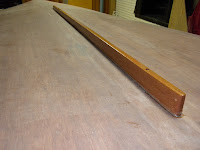
This weekend I began painting the bottom of my boat. I used Supermarine Marine Paint because it came highly recommended by another builder. There were several other reasons, like self leveling, durability, you could apply it with a roller or brush and low odor. The roller application and the low odor were very important because I am doing this in my basement.

I found the color to be just as advertised "low odor", but the primer (664 primer) odor was very strong. Lucky for me, I was able to open the outside door in the Florida room and turn a fan on. That helped a lot. The other thing that was helpful (and important), was my wife was out of town this weekend visiting my daughter in Chicago. Boy, was I glad that I did not have to listen to her saying, "Boy does that smell". I already new that. The smell from the primer went away in 24 hours. Just in time for her return. Life is good.
The paint process is going well. A coat of primer and wait 2 hours and lightly sand. While I was waiting, my brother Gary and I drove to Public Lumber in Detroit and picked up some more Mahogany Plywood. When I returned it was time for the second coat of primer, then 2 more hours to kill so I took off to airport and changed the oil in my airplane. Then it was time to apply the color (300MT Burgundy, SM-1000 Revolution). The color went on great and flowed out nice. Now I will wait for 48 hours, lightly sand and apply a second coat of color.
A couple of things that I did, that worked out good for me were that I lightly sanded between each coat of primer and color with 220 grit paper. I also went to the dollar store and bought a small ladle. Using the ladle was an easy way for me to measure the 10% thinner that I needed to add to the color. Another thing that I was worried about was when to pull the tape. I used the green tape. This green tape is great and leaves a nice line. I painted both coats of primer and the color with the same tape. I waited 30 minutes after applying the color and then pulled the tape off. No problems at all, the tape came off the boat great and no paint came with it.















